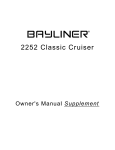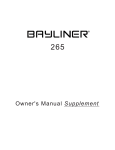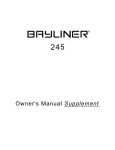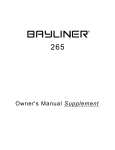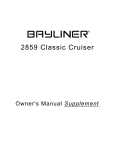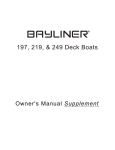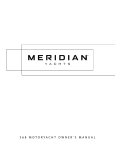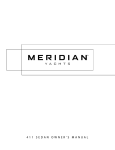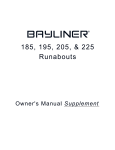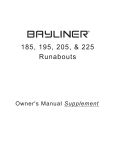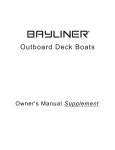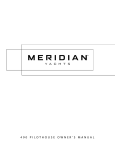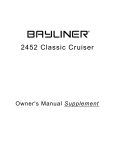Download Bayliner 275 Specifications
Transcript
Engine Serial Number: _____________________________________________ Hull Identification Number:__________________________________________ Hull Identification Number • The Hull Identification Number (HIN) is located on the starboard side of the transom. • Record the HIN (and the engine serial numbers) in the space provided above. • Include the HIN with any correspondence or orders. HIN LOCATION TRANSOM © 2004 Bayliner Technical Publications. All rights reserved. No part of this publication may be reproduced, stored in any retrieval system, or transmitted in any form by any means, electronic, mechanical, photocopying, recording or otherwise, without prior written permission of Bayliner. Printed in the United States of America. General Notes The material in this document is for information only and is subject to change without notice. While reasonable efforts have been made in the preparation of this document to assure its accuracy, Bayliner assumes no liability resulting from errors or omissions in this document, or from the use of information contained herein. Due to our commitment to product improvement, Bayliner reserves the right to make changes in the product design, specifications, and equipment at any time without notice or obligation. Illustrations and/or photos may show optional equipment. All Bayliner products meet or exceed USCG (United States Coast Guard) and/or NMMA (National Marine Manufacturer’s Association) construction standards. Manufactured with 1,1,1 Trichloroethane, a substance which harms public health and environment during the manufacturing process by destroying ozone in the upper atmosphere. Proprietary Rights This document discloses subject matter in which Bayliner has proprietary rights. The information and design disclosed herein were originated by and are the property of Bayliner. Neither receipt nor possession thereof confers or transfers any right to reproduce, copy, alter or disclose the document or any part thereof, any information contained therein, or to construct boats or any item from it, except by written permission from or written agreement with Bayliner. This document is to be returned upon request to Bayliner. CONTENTS 1 Chapter 1: Welcome Aboard! 24 Chapter 3: Propulsion & Related Systems 1 Dimensions and Tank Capacities 1 Layout View 24 Engine 1 Dealer Service 24 Bilge Blower System 2 Warranty Information 25 2 Boating Experience 2 Engine & Accessories Guidelines 3 Propeller 3 Engine & Accessories Literature 3 Qualified Maintenance 4 5 28 Fire Suppression System (If Equipped) Safety Standards 29 Chapter 4: Controls & Gauges Special Care For Moored Boats 29 Steering 29 Shift/Throttle Control 29 Power Trim and Tilt 30 Trim Tabs 31 Gauges 5 Sacrificial Anodes (Zincs) 6 Boat Lifting 7 Carbon Monoxide (CO) 7 8 8 9 9 9 9 10 Facts about CO Where and How CO Can Accumulate How to Protect Yourself and Others From CO Trip Checklist Monthly Checklist Annual Checklist Carbon Monoxide Alarm System More Information 11 Chapter 2: Locations 11 Exterior Views 11 Hull Views 12 Deck Views 13 Helm 14 Fuel System 26 Fuel Fill & Vent 26 Gas Engine Fuel Filters 27 Fuel/Water Separator Filter (Diesel Engine Only) 27 Anti-siphon Valve (Gas Engine Only) Component Locations 31 31 31 31 Cleaning Gauges Gauge Fogging Radio Transmission Interference Fuel Gauge 32 Chapter 5: Navigation & Communication Equipment 32 Compass 32 Depth Finder 32 VHF Radio (If Equipped) 33 Chapter 6: Plumbing 49 Chapter 10: Lights 33 Bilge Pumps 49 Care and Maintenance 34 Bilge Pump Testing 35 Autofloat Switches 49 Interior & Exterior Lights 49 Navigation Lights 36 Seacocks 36 Seawater Strainers 49 Spotlight (If Equipped) Freshwater System 50 Chapter 11: Heating & Air Conditioning 50 Air Conditioning System (If Equipped) 51 Chapter 12: Electrical System 36 37 Seawater Systems 38 39 39 40 40 Freshwater System Winterization Water Heating System (If Equipped) Winterizing the Water Heater Transom Shower (If Equipped) Drain Systems 40 Deck Drains 40 Gray Water Drains 40 41 52 Shower Drain System Marine Head with Holding Tank (If Equipped) 41 Using The Marine Head 41 Winterizing The Marine Head 41 Macerator (If Equipped) 42 Chapter 7: Deck Equipment 42 Cleats and Tow Eyes 42 Windlass (If Equipped) 43 Canvas 54 57 46 Alcohol/Electric Stove 47 Refrigerator 47 Audio Equipment 48 Chapter 9: Convertible Seats, Beds, & Tables 48 Dinette 120-Volt AC System Electrical Routings 57 12-Volt Direct Current Electrical Harness 58 120-Volt Alternating Current Electrical Harness 59 Battery Cable Routings 60 Bonding Harness 61 Deck Harness Routing System 62 Chapter 8: Appliances & Entertainment Systems Batteries Battery Switch Fuses and Circuit Breakers 12-Volt Accessory Outlets Alternator Battery Charger 55 Shore Power 56 Connecting To Shore Power 44 Canvas Care 45 Clear Vinyl Care 46 12-Volt DC System 52 52 52 52 53 53 Wiring Diagrams 62 Direct Current Electrical System 63 Single Shore Power (If Equipped) 64 Dual Shore Power (If Equipped) 65 Important Records 66 Float Plan Hazard Boxes & Symbols The hazard boxes and symbols shown below are used throughout this Supplement to call attention to potentially dangerous situations which could lead to either personal injury or product damage. Read ALL warnings carefully and follow all safety instructions. ! DANGER! This box alerts you to immediate hazards which WILL cause severe personal injury or death if the warning is ignored. ! WARNING! This box alerts you to hazards or unsafe practices which COULD result in severe personal injury or death if the warning is ignored. ! CAUTION! This box alerts you to hazards or unsafe practices which COULD result in minor personal injury or cause product or property damage if the warning is ignored. NOTICE This box calls attention to installation, operation or maintenance information, which is important to proper operation but is not hazard related. FIRE HAZARD! EXPLOSION HAZARD! FALLING HAZARD! NO OPEN FLAME! ROTATING PROPELLER HAZARD! ELECTRICAL HAZARD! HOT HAZARD! RUN BILGE BLOWERS FOR 4 MINUTES! CO POISONING HAZARD! 275 • Owner’s Manual Supplement Chapter 1: Welcome Aboard! • This Owner’s Manual Supplement provides information about your boat that is not covered in the Cruiser & Yacht Owner’s Manual. • Before using your boat, study this Owner’s Manual Supplement, the Cruiser & Yacht Owner’s Manual, and all engine and accessory literature carefully. • Keep this Owner’s Manual Supplement and the Cruiser & Yacht Owner’s Manual on your boat in a secure, yet readily available place. Dimensions and Tank Capacities Overall Bridge Length Clearance Beam 26' 7" 7' 3" 9' 5" Draft (Hull) Draft (Maximum) 1' 9" 3' 2" Fuel Capacity Freshwater Waste Holding (gal.) Capacity (gal.) Tank Capacity (gal.) 84 31 20 Layout View stove Dealer Service • • • • • Your dealer is your key to service. Ask your dealer to explain all systems before taking delivery of your boat. Contact your dealer if you have any problems with your new boat. If your dealer cannot help, call our customer service hotline: 360-435-8957 or send us a FAX: 360-403-4235. Buy replacement parts from any authorized Bayliner dealer. 1 Chapter 1: Welcome Aboard! 275 • Owner’s Manual Supplement Warranty Information • Bayliner offers a Limited Warranty on each new Bayliner purchased through an authorized Bayliner dealer. • A copy of the Limited Warranty was included in your owner’s packet. • If you did not receive a copy of the Limited Warranty, please contact your Bayliner dealer or call 360-435-8957 for a copy. Boating Experience ! WARNING! CONTROL HAZARD! A qualified operator must be in control of the boat at all times. DO NOT operate your boat while under the influence of alcohol or drugs. If this is your first boat or if you are changing to a type of boat you are not familiar with, for your own comfort and safety, obtain handling and operating experience before assuming command of this boat. Take one of the boating safety classes offered by the U.S. Power Squadrons or the U.S. Coast Guard Auxiliary. For more course information, including dates and locations of upcoming classes, contact the organizations directly: • U.S. Power Squadrons: 1-888-FOR-USPS (1-888-367-8777) or on the Internet at: http://www.usps.org • In Canada, for the CPS courses call 1-888-CPS-BOAT. • U.S. Coast Guard Auxiliary: 1-800-368-5647 or on the Internet at: http://www.cgaux.org Outside the United States, your selling dealer, national sailing federation or local boat club can advise you of local sea schools or competent instructors. Engine & Accessories Guidelines NOTICE When storing your boat please refer to your engine’s operation and maintenance manuals. • Your boat’s engine and accessories were selected to provide optimum performance and service. • Installing a different engine or other accessories may cause unwanted handling characteristics. • Should you choose to install a different engine or to add accessories that will affect the boat’s running trim, have an experienced marine technician perform a safety inspection and handling test before operating your boat again. Certain modifications to your boat will result in cancellation of your warranty protection. • Always check with your dealer before making any modifications to your boat. 2 275 • Owner’s Manual Supplement Chapter 1: Welcome Aboard! Propeller ! CAUTION ENGINE DAMAGE HAZARD! The factory standard propeller may not be the best for your particular boat and load conditions. Refer to the engine manual for engine RPM ratings. The engine should reach, but not exceed its full rated RPM when full-throttle is applied. Immediately contact your local Bayliner dealer if: • The engine cannot reach its full rated RPM when full-throttle is applied, or; • The engine exceeds its full rated RPM when full-throttle is applied. • Keep the propeller in good repair and at the correct pitch for your particular situation. • A slightly bent or nicked propeller will adversely affect the performance of your boat. Engine & Accessories Literature • The engine and accessories installed on your boat come with their own operation and maintenance manuals. • Read these manuals before using the engine and accessories. • Unless noted otherwise, all engine and accessory literature referred to in this Supplement is included in your owner’s packet. Qualified Maintenance ! WARNING! To maintain the integrity and safety of your boat, allow only qualified personnel to perform maintenance on, or in any way modify the: • Steering System • Propulsion System • Engine Control System • Fuel System • Environmental Control System • Electrical System • Navigational System. • Failure to maintain your boat’s systems (listed in the warning above) as designed could violate the laws in your jurisdiction and could expose you and other people to the danger of bodily injury or accidental death. • Follow the instructions provided in the Cruiser & Yacht Owner’s Manual, this Supplement, the engine owner’s manual and all accessory literature. 3 Chapter 1: Welcome Aboard! 275 • Owner’s Manual Supplement Safety Standards ! DANGER! FALLING and ROTATING PROPELLER HAZARD! • NEVER allow anyone to ride on parts of the boat not designed for such use. • Sitting on seat backs, lounging on the forward deck, bow riding, gunwale riding or occupying the transom platform while underway is especially hazardous and will cause personal injury or death. ! DANGER! ROTATING PROPELLER and CARBON MONOXIDE POISONING HAZARD! • NEVER allow anyone to occupy, or hang from, the back deck or swim platform while the engine(s) are running. • Teak surfing, dragging, or water skiing within 20 feet of a moving watercraft can be fatal. ! DANGER! DANGER PERSONAL SAFETY HAZARD! ALWAYS secure the anchor and other loose objects before getting underway. The anchor and other items that are not properly secured can come loose when the boat is moving and cause personal injury or death. • Your boat’s mechanical and electrical systems were designed to meet safety standards in effect at the time it was built. • Some of these standards were mandated by law, all of them were designed to insure your safety, and the safety of other people, vessels and property. In addition to this Supplement, please read the Cruiser & Yacht Owner’s Manual and all accessory instructions for important safety standards and hazard information. 4 275 • Owner’s Manual Supplement Chapter 1: Welcome Aboard! Special Care For Moored Boats NOTICE • To help seal the hull bottom and reduce the possibility of gelcoat blistering on moored boats, apply an epoxy barrier coating. • The barrier coating should be covered with several coats of anti-fouling paint. • Many states regulate the chemical content of bottom paints in order to meet environmental standards. Check with your local dealer about recommended bottom paints, and about the laws in effect in your area. • Whether moored in saltwater or freshwater, your boat will collect marine growth on its hull bottom. • This will detract from the boat’s beauty, greatly affect its performance and may damage the gelcoat. • Periodically haul the boat out of the water and scrub the hull bottom with a bristle brush and a solution of soap and water. Sacrificial Anodes (Zincs) NOTICE • Do not paint between the zinc and the metal surface it contacts and do not paint over the zincs. • If the zincs are not bonded correctly, they will not provide protection. Your boat is equipped with sacrificial anodes (zincs) to protect underwater metal parts from excessive deterioration. Check the zincs regularly and replace them if they have deteriorated more than 70%. There are many factors that affect the rate at which the zincs deteriorate, including: • Water temperature. • Salinity. • Water pollution. • Stray electrical current from the boat or dock may cause complete deterioration in just a few weeks. • If there is rapid zinc deterioration, measure the electrolytic corrosion around your boat with a Corrosion Test Meter. 5 Chapter 1: Welcome Aboard! 275 • Owner’s Manual Supplement Boat Lifting WARNING! ! PERSONAL INJURY and /or PRODUCT OR PROPERTY DAMAGE HAZARD! • Lifting slings may slip on the hull. • Avoid serious injury or death by securing the lifting slings together before lifting. WARNING! ! PERSONAL INJURY and /or PRODUCT OR PROPERTY DAMAGE HAZARD! • NEVER lift any boat using the cleats, or the bow and stern eyes. ! WARNING! PERSONAL INJURY and /or PRODUCT OR PROPERTY DAMAGE HAZARD! • Water in the bilge can shift and change the balance of the load. • If water is present in the bilge, pump or drain the water out of the bilge areas before lifting your boat. ! CAUTION PRODUCT or PROPERTY DAMAGE HAZARD! • When lifting any boat, always use a spreader bar. The spreader bar must be equal to the width of the boat at each lifting point. LIFTING SLING LABELS (TYPICAL PORT & STARBOARD) 3.5" • • • • 6 42.5" Always follow the lift equipment’s instructions and requirements. Water in the bilge can shift and change the balance of the load. If water is present in the bilge, pump or drain the water out of the bilge areas before lifting your boat. When lifting your boat, always position the lifting slings at the port and starboard lifting sling label positions as shown in the illustration. 275 • Owner’s Manual Supplement Chapter 1: Welcome Aboard! Carbon Monoxide (CO) ! DANGER! • Carbon monoxide gas (CO) is colorless, odorless, tasteless, and extremely dangerous. • All engines, generators, and fuel burning appliances produce CO as exhaust. • Prolonged exposure to low concentrations or very quick exposure to high concentrations will cause BRAIN DAMAGE or DEATH. • Teak surfing, dragging, or water skiing within 20 feet of a moving watercraft can be fatal. Facts about CO • CO poisoning causes a significant number of boating deaths each year. • Called the 'silent killer', CO is an extremely toxic, colorless, odorless and tasteless gas. • CO can harm or even kill you inside or outside your boat. • CO can affect you whether you’re underway, moored, or anchored. • CO symptoms are similar to seasickness or alcohol intoxication. • CO can make you sick in seconds. In high enough concentrations, even a few breaths can be fatal. • Breathing CO blocks the ability of your blood to carry oxygen. • The effects are cumulative, even low levels of exposure can result in injury or death. Factors That Increase the Effects of CO Poisoning • Age • Smokers or people exposed to high concentrations of cigarette smoke • Consumption of alcohol • Lung disorders • Heart problems • Pregnancy 7 Chapter 1: Welcome Aboard! 275 • Owner’s Manual Supplement Where and How CO Can Accumulate Stationary Conditions That Increase CO Accumulations Include: A. Using engine, generator, or other fuel burning device when boat is moored in a confined space. B. Mooring too close to another boat that is using its engine, generator, or other fuel burning device. To correct stationary situations A and/or B: • Close all windows, portlights and hatches. • If possible, move your boat away from source of CO. Running Conditions That Increase CO Accumulations Include: C. Running boat with trim angle of bow too high. D. Running boat without through ventilation (station wagon effect). To correct running situations C and/or D: • Trim bow down. • Open windows and canvas. • When possible, run boat so that prevailing winds help dissipate exhaust. How to Protect Yourself and Others From CO • Know where and how CO may accumulate in and around your boat (see above). • Maintain fresh air circulation throughout the boat at all times. • Know where your engine and generator exhaust outlets are located and keep everyone away from these areas. • Never sit on, or hang onto, the back deck or swim platform while the engine(s) are running. • Never enter the areas under swim platforms where exhaust outlets are located. • Although CO can be present without the smell of exhaust fumes, if exhaust fumes are detected on the boat, take immediate action to dissipate these fumes. • Treat symptoms of seasickness as possible CO poisoning. Get the person into fresh air immediately. Seek medical attention—unless you’re sure it’s not CO. • Install and maintain CO alarms inside your boat. Do not ignore any alarm. Replace alarms as recommended by the alarm manufacturer. • Follow the checklists provided on the next page. • Get a Vessel Safety Check. For information on how to get a free VESSEL SAFETY CHECK, visit www.vesselsafetycheck.org or contact your local U.S. Coast Guard Auxiliary or United States Power Squadrons®. • U.S. Coast Guard Auxiliary: 1-800-368-5647 or on the Internet at: http://www.cgaux.org • U.S. Power Squadrons: 1-888-FOR-USPS (1-888-367-8777) or on the Internet at: http://www.usps.org 8 275 • Owner’s Manual Supplement Chapter 1: Welcome Aboard! Trip Checklist ❏ Make sure you know where the exhaust outlets are located on your boat. ❏ Educate all passengers about the symptoms of CO poisoning and where CO may accumulate. ❏ When docked, or rafted with another boat, be aware of exhaust emissions from the other boat. ❏ Listen for any change in exhaust sound, which could indicate an exhaust component failure. ❏ Test the operation of each CO alarm by pressing the test button. Monthly Checklist ❏ Make sure all exhaust clamps are in place and secure. ❏ Look for exhaust leaking from exhaust system components. Signs include rust and/or black streaking, water leaks, or corroded or cracked fittings. ❏ Inspect rubber exhaust hoses for burned, cracked, or deteriorated sections. All rubber hoses should be pliable and free of kinks. Annual Checklist Have a Qualified Marine Technician: ❏ Replace exhaust hoses if cracking, charring, or deterioration is found. ❏ Ensure that your engines and generators are properly tuned, and well maintained. ❏ Inspect each water pump impeller and the water pump housing. Replace if worn. Make sure cooling systems are in working condition. ❏ Inspect all metallic exhaust components for cracking, rusting, leaking, or loosening. Make sure they check the cylinder head gasket, exhaust manifold, water injection elbow, and the threaded adapter nipple between the manifold and the elbow. ❏ Clean, inspect, and confirm proper operation of the generator cooling water anti-siphon valve (if equipped). Carbon Monoxide Alarm System NOTICE • The stereo memory and CO monitor(s) place a small, but constant drain on the battery. • If your boat will be unattended for an extended amount of time, plug into shore power with the battery charger turned On. • Do not disconnect the alarm system. • Read the manufacturer’s instructions for your CO alarm system. If you did not receive an instruction manual, call (800) 383-0269 and one will be mailed to you. If your boat is not equipped with a carbon monoxide alarm, consider purchasing one from your dealer or marine supply store. 9 Chapter 1: Welcome Aboard! 275 • Owner’s Manual Supplement More Information For more information about how you can prevent carbon monoxide poisoning on recreational boats and other ways to boat more safely, contact: United States Coast Guard Office of Boating Safety (G-OPB-3) 2100 Second Street SW Washington, DC 20593 www.uscgboating.org 1-800-368-5647 National Marine Manufacturers Association (NMMA) 200 East Randolph Drive Suite 5100 Chicago, IL 60601-9301 www.nmma.org 312-946-6200 American Boat & Yacht Council, Inc. (ABYC) 3069 Solomon’s Island Road Edgewater, MD 21037-1416 www.abycinc.org 410-956-1050 For information on how to get a free VESSEL SAFETY CHECK, visit www.vesselsafetycheck.org or contact your local U.S. Coast Guard Auxiliary or United States Power Squadrons®. • U.S. Coast Guard Auxiliary: 1-800-368-5647 or on the Internet at: http://www.cgaux.org U.S. Power Squadrons: 1-888-FOR-USPS (1-888-367-8777) or on the Internet at: http://www.usps.org 10 275 • Owner’s Manual Supplement Chapter 2: Locations Exterior Views Hull Views HOLDING TANK VENT STORAGE DRAIN SHOWER PUMP DRAIN PORTLIGHTS FUEL TANK VENT STARBOARD HULLSIDE BOW EYE COCKPIT DRAINS AFT BILGE PUMP DRAIN FORWARD BILGE PUMP DRAIN PORTLIGHT HEAD SINK DRAIN GALLEY SINK DRAIN WATER TANK VENT PORT HULLSIDE ANCHOR LOCKER DRAIN AIR CONDITIONER DRAINS (IF EQUIPPED) COCKPIT DRAINS MACERATOR DISCHARGE (IF EQUIPPED) BOARDING LADDER TRANSOM TRIM TAB STERN EYES TRIM TAB GARBOARD DRAIN SPEEDOMETER PICKUP (IF EQUIPPED) 11 Chapter 2: Locations 275 • Owner’s Manual Supplement Deck Views FORWARD & STARBOARD SIDE WINDLASS CONTROLS (IF EQUIPPED) ANCHOR WINDLASS TRANSOM SHOWER (IF EQUIPPED) NAVIGATION LIGHT SPOTLIGHT (IF EQUIPPED) ANCHOR ROLLER HORN NAVIGATION LIGHT BOW HATCH FUEL FILL DECK FITTING CLEAT (TYPICAL) AFT & PORT SIDE CLEAT SHORE POWER INLET WASTE PUMP-OUT DECK FITTING CLEAT WATER FILL DECK FITTING 12 275 • Owner’s Manual Supplement Chapter 2: Locations Helm NOTE: TYPICAL HELM LAYOUT SHOWN ACTUAL LAYOUT MAY VARY DEPENDING ON ENGINE AND ACCESSORY OPTIONS VOLTMETER TEMPERATURE GAUGE OIL PRESSURE GAUGE TACHOMETER FUEL GAUGE SPEEDOMETER TRIM & TILT GAUGE 12-VOLT RECEPTACLE DEPTH FINDER SWITCH PANEL VHF RADIO (IF EQUIPPED) IGNITION SWITCH DC CIRCUIT BREAKER PANEL 13 Chapter 2: Locations 275 • Owner’s Manual Supplement Component Locations 12-Volt Accessory Outlets (2): • One is located at the helm on the dash. 12-VOLT RECEPTACLE • The other is located forward of the AC panel in the galley. Air Conditioner Seawater Intake Seacock (If Equipped): • Located on the starboard side of the engine room. 14 AC PANEL 12-VOLT RECEPTACLE AIR CONDITIONER SEAWATER INTAKE SEACOCK (IF EQUIPPED) 275 • Owner’s Manual Supplement Chapter 2: Locations Air Conditioner Unit (If Equipped): • Located in the aft port storage locker under the v-berth mattress. AIR CONDITIONER (IF EQUIPPED) AC Panel: • Located in the galley. AC PANEL Batteries: • Locations are one on each side of the engine, in the engine room BATTERIES 15 Chapter 2: Locations 275 • Owner’s Manual Supplement Battery Charger: • Located on the port side of the engine room, on the forward wall. BATTERY CHARGER Battery Switch: • Located inside the storage hatch under the helm seat. BATTERY SWITCH Bilge Pump and Float Switch - Aft: • Located in the engine room. 16 AFT BILGE PUMP & FLOAT SWITCH 275 • Owner’s Manual Supplement Chapter 2: Locations Bilge Pump and Float Switch - Forward: • Located under the bottom entry step. • Access the bilge pump and float switch by lifting up the bottom entry step. CO MONITOR Carbon Monoxide Monitor: • Located on the ceiling, above the aft dinette seat. BOTTOM ENTRY STEP DC Circuit Breakers: • The DC main circuit breaker and the circuit breakers for the 'standby loads' are located on the battery switch panel. Access the battery switch panel through the storage hatch under the helm seat • The rest of the DC circuit breakers are located on a panel below the helm. DC CIRCUIT BREAKERS Depth Sounder Thru-hull Transducer: • Located in the engine room, forward of the engine. TRANSDUCER 17 Chapter 2: Locations 275 • Owner’s Manual Supplement Engine Circuit Breaker: • Located on the engine, in the engine room. ENGINE CIRCUIT BREAKERS DIESEL ENGINE GAS ENGINE Engine Room: • Access the engine room by lifting the cockpit floor hatch. COCKPIT FLOOR HATCH Freshwater Fill Deck Fitting: • Located above the swim platform, on the port side of the aft deck. FRESHWATER FILL DECK FITTING 18 275 • Owner’s Manual Supplement Chapter 2: Locations Freshwater Pump: • Located on the port side of the engine room. WATER PUMP Freshwater Pump Switch: • Located at the forward end of the galley. WATER PUMP SWITCH Freshwater Tank: • Located on the port side of the engine room. FRESH WATER TANK 19 Chapter 2: Locations 275 • Owner’s Manual Supplement Fuel Fill Deck Fitting: • Located on the starboard side of the deck just aft of the ventilation cover. FUEL FILL DECK FITTING Fuel Shut-off Valve (Diesel Engine Only): • Located on the port wall of the cockpit. FUEL SHUTOFF VALVE Fuel Tank: • Located in the engine room. 20 FUEL TANK 275 • Owner’s Manual Supplement Chapter 2: Locations Macerator Underwater Discharge Seacock (If Equipped): • Located in the starboard aft corner of the engine room. MACERATOR UNDERWATER DISCHARGE SEACOCK (IF EQUIPPED) Marine Head Seawater Intake Seacock: • Located under the bottom entry step. • Access the seacock by lifting up the bottom entry step. BOTTOM ENTRY STEP Shore Power Inlet: • Located on the port side of the deck. SHORE POWER INLET 21 Chapter 2: Locations Shower Drain Pump: • Located in the storage compartment under the sink in the head. Shower Drain Pump Switch: • Located in the head. 275 • Owner’s Manual Supplement SHOWER DRAIN PUMP SWITCH VANITY DOORS Spotlight (If Equipped) • Located on the bow. SPOTLIGHT (IF EQUIPPED) Spotlight Control (If Equipped): • Located on the helm. SPOTLIGHT CONTROL (IF EQUIPPED) 22 275 • Owner’s Manual Supplement Chapter 2: Locations Waste Holding Tank: • Located on the starboard side of the engine room. WASTE HOLDING TANK Waste Pump-Out Deck Fitting: • Located on the starboard aft corner of the deck, just above the swim platform and next to the transom door. WASTE PUMP-OUT DECK FITTING 23 275 • Owner’s Manual Supplement Chapter 3: Propulsion & Related Systems Engine Read the engine operation and maintenance manuals before starting or doing any maintenance on the engine. Bilge Blower System ! WARNING! FIRE/EXPLOSION HAZARD • Use of the bilge blower system is NOT A GUARANTEE that explosive fumes have been removed. • BEFORE starting the engine ALWAYS use the 'sniff test' to check the engine and bilge areas for fuel vapors. • If you smell fuel, DO NOT start the engine and DO NOT turn On any electrical devices. • If you smell fuel and the engine is already running, shut Off the engine and turn Off all electrical devices. Investigate immediately. • DO NOT obstruct or modify the bilge blower system. The bilge blower removes explosive fumes from the engine and bilge areas. Fresh air is drawn into the engine and bilge areas through the vents. To make sure the engine and bilge areas are properly ventilated: • Use the 'sniff test' to check the engine and bilge areas for fuel vapors before starting the engine. • Always run the bilge blower for at least four minutes before starting the engine. • Continue to run the blower until your boat has reached cruising speed. • Always run the blower when running the boat below cruising speed. 24 BILGE BLOWER SYSTEM ROUTING VENTILATION HOSES BLOWER MOTOR 275 • Owner’s Manual Supplement Chapter 3: Propulsion & Related Systems Fuel System ! WARNING! FIRE, EXPLOSION AND OPEN FLAME HAZARD! • It is very important that the fuel system be inspected thoroughly the first time it is filled and at each subsequent filling. • Read the fueling instructions in the engine operation manual. ! CAUTION Avoid the storage or handling of gear near the fuel lines, fittings and tank. NOTICE • On diesel engine models, air in the diesel supply system can stop an engine or severely restrict performance. • If you suspect air in the fuel lines, refer to your engine operation manual for detailed instructions on how to bleed the system. NOTICE Carefully read the fuel section of both the Cruiser & Yacht Owner’s Manual and the engine operation manual, paying special attention to the subject of fuel recommendations. GAS FUEL LINE ROUTING (IF EQUIPPED) FUEL LINE TO ENGINE FUEL TANK FUEL TANK VENT FUEL FILL DECK FITTING 25 Chapter 3: Propulsion & Related Systems 275 • Owner’s Manual Supplement DIESEL FUEL LINE ROUTING (IF EQUIPPED) FUEL SHUTOFF VALVE FUEL FILTER FUEL FEED LINE FUEL TANK FUEL RETURN LINE FUEL TANK VENT FUEL FILL DECK FITTING Fuel Fill & Vent • The fuel fill fitting is marked 'Gas' or 'Diesel'. • If you experience difficulty filling the fuel tank, see if the fuel fill hose or fuel tank vent hose is kinked or collapsed. • If there are no visible signs of a problem, contact your local dealer. Gas Engine Fuel Filters • The fuel pickup tube, located inside the fuel tank, is equipped with a fine mesh screen filter. • In addition, when supplied by the engine manufacturer, a fuel filter is installed on the engine. • Periodically replace the fuel filter to make sure it remains clean and free of debris. • Talk to your selling dealer or local marina about fuel additives that help prevent fungus or other buildup in your fuel tank. 26 275 • Owner’s Manual Supplement Chapter 3: Propulsion & Related Systems Fuel/Water Separator Filter (Diesel Engine Only) NOTICE • The frequency of water draining or element replacement is determined by the contamination level in the fuel. • Inspect the collection bowls for water daily. • Replace the elements at least once a year, or when a loss of power is noticed, whichever comes first. • The fuel feed line features a fuel/water separator filter. • Service instructions for the fuel/water separator filter is provided on the filter. HAND PRIMER VENT PLUG SERVICE INSTRUCTIONS DRAIN PLUG Anti-siphon Valve (Gas Engine Only) NOTICE • If an engine running problem is diagnosed as fuel starvation, check the anti-siphon valve. • If the valve is stuck or clogged, change or replace it while the engine is shut down. • NEVER run the engine with the anti-siphon valve removed, except in an emergency. • • • • The anti-siphon valve is a vital fuel system part. If the fuel line ruptures, this valve will prevent the fuel from siphoning from the tank. The valve is located on the fuel tank, where the fuel feed line attaches to the tank. The valve is spring loaded and is opened by fuel pump vacuum. 27 Chapter 3: Propulsion & Related Systems 275 • Owner’s Manual Supplement Fire Suppression System (If Equipped) • The fire suppression system is designed to extinguish engine compartment fires. • Before using your boat for the first time, read the fire suppression system’s instruction and maintenance manual and follow all warnings. • The system will discharge automatically whenever direct heat from a fire is detected in the engine compartment. • The system can be discharged manually by pulling the T-handle (labeled “FIRE“) at the helm. • The system can only be discharged once. • After the system is discharged it must be refilled and refurbished before it can be used again. 28 275 • Owner’s Manual Supplement Chapter 4: Controls & Gauges Steering • • • • Stern drive models feature power assisted rack-and-pinion steering. Check the fluid level in the power steering reservoir every time you use your boat. Boat steering is not self-centering. Refer to the engine manual for more steering system details. Shift/Throttle Control ! WARNING! LOSS OF CONTROL HAZARD! Improper maintenance of shift/throttle hardware may cause a sudden loss of control! • Read all of the information about the shift/throttle control in the Cruiser & Yacht Owner’s Manual. • Also, read the shift/throttle control manual and the engine manual. Power Trim and Tilt • The stern drive on your boat is equipped with power trim and tilt. • Trim and tilt instructions are provided in the engine operation manual and the shifter/throttle manual. 29 Chapter 4: Controls & Gauges 275 • Owner’s Manual Supplement Trim Tabs ! WARNING! LOSS OF CONTROL HAZARD! Improper use of trim tabs will cause loss of control! • Do not allow anyone unfamiliar with trim tabs to use them. • Do not use trim tabs in a following sea as they will cause broaching or other unsafe handling characteristics. • Do not use trim tabs to compensate for excessive unequal weight distribution. HELM VIEW TRANSOM VIEW TRIM TAB SWITCHES TRIM TAB (TYPICAL) • • • • • • • 30 Before using the trim tabs read the trim tab operation manual. The trim tabs can be used to help keep your boat level at cruising speeds. The trim tabs are controlled by two rocker switches at the helm. Once cruising speed is reached, the port or starboard trim switch may be used (one at a time) to level the boat. Perform trim tab adjustment with several short touches to the switch rather than one long one. After each short touch allow several seconds for the hull to react. Periodically (at least once a year) check the fluid level in the trim tab hydraulic fluid reservoir and refill as necessary. 275 • Owner’s Manual Supplement Chapter 4: Controls & Gauges Gauges Cleaning Gauges ! CAUTION! PRODUCT or PROPERTY DAMAGE HAZARD! • Use only mild soap and water to clean the gauge lenses and bezels. • Use of other cleaners, including common window cleaning solutions, may cause the lens to crack. • Lenses cracked in this manner will not be covered by our warranty. Gauge Fogging • Moisture may occasionally find its way into the gauges causing lens fogging. • Turning On the gauge lights will help dry the lenses. • Fogging will not harm the gauges. Radio Transmission Interference VHF or other radio transmissions may cause brief erratic readings on the tachometer. This will not damage the tachometer gauge or affect its accuracy when not transmitting. Fuel Gauge It is normal for the pointer on your fuel gauge to bounce as fuel sloshes back and forth in the fuel tank. 31 275 • Owner’s Manual Supplement Chapter 5: Navigation & Communication Equipment Read the manuals for all navigation & communication equipment before using these systems. Compass NOTICE • Compass accuracy can be affected by many factors. • Have a qualified technician calibrate your compass. • Make sure the technician gives you a deviation card which shows the corrections to apply in navigational calculations. • Keep a copy of the deviation card at the helm. Depth Finder ! WARNING! • DO NOT use the depth finder as a navigational aid to prevent collision, grounding, boat damage or personal injury. • When the boat is moving, submerged objects will not be seen until they are already under the boat. • Bottom depths may change too quickly to allow time for the boat to react. • If you suspect shallow water or submerged objects, run the boat at very slow speeds. VHF Radio (If Equipped) • Your boat may include a VHF (Very High Frequency) radio. • The VHF radio can be used to access weather reports, summon assistance or contact other vessels as permitted by the FCC (Federal Communications Commission). • Contact the FCC for licensing, rules and regulations concerning VHF radio usage. 32 275 • Owner’s Manual Supplement Chapter 6: Plumbing Bilge Pumps NOTICE Discharge of oil, oil waste or fuel into navigable waters is prohibited by law. Violators are subject to legal action by the local authorities. • Your boat is equipped with two bilge pumps for pumping water out of the bilge. • The bilge pumps are controlled by automatic float switches (auto float switches) and/or switches at the helm. • Since the bilge pumps are wired directly to the battery, they should work even when the boat is completely shut down. AFT BILGE PUMP & FLOAT SWITCH FORWARD BILGE PUMP & FLOAT SWITCH THRU-HULLS 33 Chapter 6: Plumbing 275 • Owner’s Manual Supplement Bilge Pump Testing • The bilge pumps are vital to the safety of your boat. • Test the bilge pumps often to make sure they are working properly. Testing process: 1. Turn On the manual switches at the helm. 2. Any water in the bilge should pump overboard. • If a pump motor is running, but not pumping, inspect the discharge hose for a kink or collapsed area. • If no problems are found with the discharge hose, check the bilge pump housing for clogging debris as follows: Checking for clogging debris: 1. 2. 3. 34 Remove the power cartridge: LIGHT FILM OUTER a. Lift the tab while rotating the fins OF OIL HOUSING “O” RING TAB counter-clockwise. b. Lift out the power cartridge. c. Clear the outer housing of debris. Reinstall the power cartridge: a. Make sure the “O” ring is properly seated. b. Coat the “O” ring with a light film of vegetable or mineral oil. c. Align the cams on either side of the power cartridge with the two CAM POWER SLOT FIN slots on the outer housing (TYPICAL) CARTRIDGE (TYPICAL) d. Press the power cartridge into the housing while twisting clockwise. Check the reinstallation by trying to twist the fins counter-clockwise without lifting the tab; the cartridge should stay in place. 275 • Owner’s Manual Supplement Chapter 6: Plumbing Autofloat Switches • The automatic bilge pumps use float (autofloat) switches to automatically turn On the pumps whenever water rises to a preset level in the bilge. • The autofloat switches are normally mounted next to the bilge pumps they control. • The autofloat switches should be tested often as follows. Autofloat testing: FLOAT SWITCH TESTING 1. Lift the float switch test button up to turn On the bilge pump. • If the pump does not turn On, check the fuse on the fuse block. • If the fuse is good but the switch still doesn’t work, it may mean the switch is bad or possibly the battery is low. 2. After testing, push the test button all the way down to return the float switch to auto mode. FLOAT SWITCH TEST BUTTON LIFT SWITCH UP BILGE PUMP SHOULD TURN ON ! PUSH SWITCH DOWN BILGE PUMP SHOULD TURN OFF CAUTION! When the test is completed on each float switch, you MUST push the test button all the way down to return the switch to auto mode! 35 Chapter 6: Plumbing 275 • Owner’s Manual Supplement Seawater Systems Seacocks ! CAUTION SYSTEM DAMAGE HAZARD! • Before using a seawater intake system, make sure that the system’s seacock is in the Open position before the system is started and keep the seacock Open until the system is shut Off. • Close the seacocks whenever the systems will not be used for long periods of time. A seacock is a thru-hull valve, that may be opened to let in water or discharge liquids such as waste from the holding tank. Seacocks are typically used on your boat in the following seawater intake or liquid discharge systems: • Air conditioning system (if equipped) • Marine head system Before using any of these systems, make sure that the system’s seacock is Open and remains Open until the system is shut Off. SEAWATER INTAKE VALVE (SEACOCK) COMPONENTS (TYPICAL) 90 DEGREE SEACOCK LEVER HULL SECTION SEACOCK (TYPICAL) SEACOCK GASKET INTAKE STRAINER Seawater Strainers • Seawater strainers are used in water intake systems to filter incoming seawater. • A seawater strainer is located near each system’s seacock. • Check the strainers for leaks and/or debris every time you use your boat. • If debris is found, clean the seawater strainer as follows: ! CAUTION FLOODING HAZARD! • The seacock that sends seawater to the strainer must be CLOSED before disassembling the seawater strainer to prevent the boat from taking on water through the seawater strainer assembly. • Keep the seacock CLOSED until the seawater strainer is completely reassembled. SYSTEM DAMAGE HAZARD! • After reassembling the seawater strainer, make sure that the seacock valve is OPEN before using the component/system. 1. 2. 3. 4. 5. 6. 7. 36 Make sure the component/system (marine head, air conditioning system, etc.) that the strainer is connected to is turned Off. Close the seacock that sends seawater to the strainer you are about to clean. The seacock must remain Closed until the strainer is completely reassembled. Take apart the seawater strainer. Remove the debris. Flush the strainer with water. Reassemble the seawater strainer. Open the seacock and check for leaks around the strainer. If no leaks are found, you may use the component or system. 275 • Owner’s Manual Supplement Chapter 6: Plumbing Freshwater System ! WARNING! • Only use safe drinking (potable) water in your boat’s freshwater system. • Only use a sanitary drinking water hose to fill the water tank or connect to city water. • Never use a common garden hose for drinking water. • Read the Freshwater system section in the Cruiser & Yacht Owner’s Manual. • Your boat is equipped with a pressure type (demand) freshwater (potable) system. • This system can be pressurized by turning On the water pump. • See the Locations section of this Supplement for the location of the water pump switch. • Since the water pump requires DC power, the battery switch must be turned On for the pump to work. • Turn Off the water pump when the boat is not in use or the water tank is empty. • Inspect and clean the water filter often (located on the water pump). • If your boat is to be left unattended for a long period of time, pump the water tank dry to prevent stored water from becoming stagnant and distasteful. • If the freshwater system needs to be disinfected, ask your dealer about treatments available for your boat’s system. GALLEY FAUCET HEAD WATER TANK VENT WATER TANK TRANSOM SHOWER (IF EQUIPPED) WATER FILL DECK FITTING WATER HEATER WATER PUMP 37 Chapter 6: Plumbing 275 • Owner’s Manual Supplement Freshwater System Winterization ! CAUTION! WATER SYSTEM DAMAGE HAZARD! Never blow compressed air through the water system when all of the faucets are Closed. 1. Turn On the water system switch. 2. Open all of the faucets and showers and let the water system drain completely. 3. Turn Off the water system switch. All remaining water must be removed from the water lines. There are two ways to remove the remaining water from the lines: • Compressed Air • Gravity Draining Compressed Air You must have an air compressor with an air hose and an air nozzle. 1. 2. 3. 4. 5. Remove the water line from the outlet side of the water pump (opposite side from filter). Open the faucet that is furthest away from the water pump. Place the air nozzle against the end of the just removed water line and blow air through the system. When water stops coming out of the Open faucet, stop the air and Close the faucet. One at a time, repeat this process on all faucets and showers. NOTE: LOCATION OF TEE FITTING & DRAIN PLUG MAY VARY TYPICAL VIEW DRAIN PLUG INLET SIDE WATER LINE FILTER WATER PUMP Gravity Draining 1. 2. 3. 38 Open all faucets and showers. Remove the drain plug from the tee fitting on the freshwater tank. When the water has stopped draining from the freshwater tank, replace the drain plug. OUTLET SIDE WATER LINE FRESHWATER TANK TEE FITTING 275 • Owner’s Manual Supplement Chapter 6: Plumbing Water Heating System (If Equipped) ! WARNING! SCALDING HAZARD! •Water heated by the water heater can be hot enough to scald the skin. ! CAUTION! WATER HEATER DAMAGE HAZARD! • DO NOT turn On the water heater electrical circuit on the AC panel until the water heater tank is COMPLETELY filled with water. • Even momentary operation in a dry tank will damage the heating elements. • Warranty replacements WILL NOT be made on elements damaged in this manner. • The tank is full if water flows from the tap when the hot water is turned On in the galley. • The water heater should be drained and the power turned Off when the possibility of freezing exists. NOTICE If your boat is connected to shore power, but the water heater is not working: • Make sure the water heater circuit breaker on the AC panel is switched On. If the circuit breaker on the AC panel is On, but the water heater is still not working: • Consult with your dealer about checking the 'push to reset' circuit breaker located on the water heater. • Read the water heater instruction manual and heed the warnings above. • The water heater is connected to the 120-volt, AC power system. • Turn On the water heater breaker on the AC panel to heat the water. Winterizing the Water Heater 1. 2. 3. 4. 5. • Turn Off the water heater breaker. Disconnect the hose (A) attached to the pressure relief valve (B). If there is any water in this hose, drain it into the bilge or into a bucket. Open the pressure relief valve (B). Open the drain valve (C). Leave the pressure relief and drain valves Open until you fit out the boat after storage. B A C 39 Chapter 6: Plumbing 275 • Owner’s Manual Supplement Transom Shower (If Equipped) • Read the manufacturer’s instructions before using the transom shower for the first time. • The water pump switch must be turned On before using the transom shower. TRANSOM SHOWER Drain Systems Deck Drains • Water on the deck is drained overboard through the deck drains. • Keep the deck drains free of debris. Gray Water Drains The sinks are above the waterline and are gravity drained overboard Shower Drain System • Turn on the drain pump switch to pump the shower drain water overboard. • Periodically clean the strainer. STRAINER PUMP 40 275 • Owner’s Manual Supplement Chapter 6: Plumbing Marine Head with Holding Tank (If Equipped) NOTICE Check with local authorities for regulations regarding the legal use of marine head systems. • Before using this system, read the marine head operation and maintenance manual. • The holding tank is plumbed to a waste fitting on the deck for dockside pump-out. • Look at the side of the holding tank to check the content level. • Empty the holding tank at every opportunity. HEAD INTAKE PUMP & SEAWATER STRAINER SEAWATER INTAKE SEACOCK Using The Marine Head 1. 2. 3. 4. 5. • Open the head’s seawater intake seacock. Before using the head, pump water into the bowl to wet the sides. After use, pump until the bowlis clean. Pump a few more times to clean the lines. If excess waste causes the water to rise in the bowl, stop pumping until the water recedes. Close the intake seacock while the boat is underway or whenever the boat is left moored in the water. HOLDING TANK VENT HOLDING TANK MACERATOR (IF EQUIPPED) OVERBOARD DISCHARGE SEACOCK (IF EQUIPPED) WASTE PUMP-OUT DECK FITTING Winterizing The Marine Head Read the marine head operation and maintenance manual for winterizing instructions. Macerator (If Equipped) NOTICE Check with local authorities for regulations regarding the legal use of marine head systems. To use the macerator to pump waste directly into the water (where regulations permit): 1. 2. 3. Open the underwater discharge seacock. Press both macerator switches at the same time to run the pump. Do not continue running the macerator if the waste holding tank is empty. Close the underwater discharge seacock when you are done pumping. 41 275 • Owner’s Manual Supplement Chapter 7: Deck Equipment Cleats and Tow Eyes ! WARNING! PERSONAL INJURY and /or PRODUCT or PROPERTY DAMAGE HAZARD! • NEVER lift the boat using the cleats, bow and stern eyes. Carefully read the section on towing in the Cruiser & Yacht Owner’s Manual before: • Towing anything behind the boat. • Being towed by another vessel. Windlass (If Equipped) ! DANGER! DANGER PERSONAL SAFETY HAZARD! ALWAYS secure the anchor and other loose objects before getting underway. The anchor and other items that are not properly secured can come loose when the boat is moving and cause personal injury or death. ! CAUTION PRODUCT DAMAGE HAZARD! • DO NOT pull the boat to the anchor using the windlass or continue to run the windlass if it has stalled or is overloaded. • • • • • • • 42 Your boat may feature an anchor windlass. Read and follow the manufacturer’s instruction manual before using the anchor windlass for the first time. The windlass can be controlled from a switch at the helm or from the deck foot switches. Make sure that the windlass breaker is turned On before using the anchor windlass. To haul the anchor, use engine power (not the windlass) to move the boat to, and directly above, the anchor. Dislodge the anchor from the bottom by pulling it straight up with the windlass. Make sure the anchor is secured before getting underway. 275 • Owner’s Manual Supplement Chapter 7: Deck Equipment Canvas ! CAUTION PRODUCT or PROPERTY DAMAGE HAZARD! Take down and securely stow ALL canvas before transporting your boat by road. NOTICE Two people are needed for most of the tasks listed in this section. B E C F I A H G D 1. 2. Slide the swivel ends (A) of the main bow (B) over the side windshield frames (C) and insert the pins (D). Unfold the canvas top and slide the swivel ends of the forward legs (E) over the windshield frame and insert the pins. 3. Slide the eye ends (F) of the aft legs (G) into the deck hinges (H) and insert the pins. • The jaw slides (I) should not need to be adjusted. • However, if you think the jaw slides need to be adjusted, obtain the measurements from your selling dealer. 43 Chapter 7: Deck Equipment 275 • Owner’s Manual Supplement Canvas Care (see also, ‘Clear Vinyl Care’ on next page) After each use, especially in saltwater, rinse the canvas with cold freshwater. Before stowing, let the canvas air dry completely. • The canvas can be rolled or folded for stowage. Regularly clean the canvas to prevent dirt, pollen, and etc. from embedding in the fabric. Generally, it is easiest to wash the canvas while it is installed on the boat. ! CAUTION Never use detergents when washing the canvas. Detergents can destroy the water repellency and mildew/UV resistant finish of your canvas. 1. 2. 3. 4. 5. Use a soft-bristled brush to remove all dust and loose dirt. Hose down the canvas with freshwater. Gently wash the canvas with a solution of lukewarm water (no more than 100 F) and non-detergent soap, such as Lux or Ivory Flakes. Rinse thoroughly to remove the soap. Before stowing, let the canvas dry completely. Stubborn Stains ! CAUTION • Soaking in bleach solutions may remove the waterproof finish of the fabric and may also decrease the life of the polyester thread used in the canvas. • If necessary, a water repellent treatment should be re-applied to your canvas. Ask your dealer about the treatments available for your boat’s canvas. Some stubborn stains may resist normal washing and you can try the following methods. However, these methods may remove the waterproof finish of the fabric and may also decrease the life of the polyester thread used in the canvas. Reapply a water repellent treatment as necessary. Method 1 1. 2. 3. Add 1/8 cup (2 oz.) of non-chlorine bleach to one gallon of water and mix thoroughly. Thoroughly wet the canvas and then gently scrub the stained area with the weak bleach solution. Rinse with cold water to remove all of the solution. Method 2 1. 2. 3. 44 Add 1/2 cup (4 oz.) of non-chlorine bleach and 1/2 cup (4 oz.) Ivory Flakes to one gallon of water and mix thoroughly. Soak the canvas in this solution for about 20 minutes. Rinse with cold water to remove all of the solution. 275 • Owner’s Manual Supplement Chapter 7: Deck Equipment Clear Vinyl Care • • • • • ! CAUTION Never store the clear vinyl pieces wet, as this will cause a milky film to develop. Never fold or crease the clear vinyl pieces as cracking will occur. Clear vinyl is not intended for use when the boat is in storage or being moored. Clear vinyl does not hold up well against ultraviolet rays. Under direct sunlight conditions, do not let the clear vinyl touch the framework. The framework radiates heat and can burn the clear vinyl. After each use, especially in saltwater, rinse the clear vinyl with cold freshwater. Before stowing, let the clear vinyl air dry completely. • The clear vinyl can be rolled or laid out NEVER FOLD OR CREASE CLEAR VINYL! FOLDING OR OTHERWISE CREASING flat for stowage. CLEAR VINYL WILL CAUSE DAMAGE SUCH AS CRACKING TO OCCUR • Never fold or crease the clear vinyl parts as cracking will occur. AFTER CLEAR VINYL PARTS HAVE COMPLETELY AIR DRIED THEY CAN BE ROLLED OR SIMPLY LAID FLAT FOR STOWAGE Regularly clean the clear vinyl to prevent dirt, pollen, and etc. from marring the surface. Generally, it is easiest to clean the clear vinyl while it is installed on the boat. 1. 2. Hose down the clear vinyl with freshwater. Using a soft cotton cloth (paper towels are abrasive and should never be used on clear vinyl), gently wash the clear vinyl with soap and water. 3. Rinse thoroughly to remove the soap. 4. Before stowing, the clear vinyl must be completely dry. Air drying is best, but you can also carefully dry the vinyl with a chamois or soft cotton cloth. • Ask your dealer about products available to keep the clear vinyl polished and looking new. 45 275 • Owner’s Manual Supplement Chapter 8: Appliances & Entertainment Systems NOTICE Always keep an approved ABC-type fire extinguisher in galley area. • The separate instruction sheets or manuals for all appliances and entertainment systems contain detailed instructions and important safeguards. • Read the instruction sheets and manuals before using your boat’s appliances and entertainment systems. • If applicable, make sure the AC breaker is turned On for the appliance or entertainment system you wish to use. Alcohol/Electric Stove ! DANGER! CARBON MONOXIDE POISONING HAZARD! • The alcohol stove is a source of dangerous carbon monoxide gas (CO). • Before using the alcohol stove, Open doors and windows to make sure there is enough fresh air for ventilation. ! WARNING! • Open flame cooking appliances consume oxygen, this can cause asphyxiation or death. • Maintain open ventilation. ! WARNING! BURN/SCALDING and/or FIRE HAZARD! • • • • • Read the stove’s instruction manual before using. Always keep an approved ABC-type fire extinguisher in galley area. Do not use the stove while underway. Any non-cooking devices on or near your stove during use are potential fire hazards! Do not touch burners, grates or nearby surfaces as they may be hot even when they are dark in color. • Areas near burners and grates may become hot enough to cause burns. • During and after use, do not touch or let clothing or other flammable material come in contact with heated units or areas near the units (burner tops, main frame sides and back, sea rails and pot holders) until they have had sufficient time to cool. ! CAUTION PRODUCT DAMAGE HAZARD! To prevent overheating which can destroy the electric burner elements, NEVER attempt to use both alcohol and electric burners at the same time. 46 275 • Owner’s Manual Supplement Chapter 8: Appliances & Entertainment Systems Refrigerator The refrigerator runs on 12-volt DC power unless 120-volt AC power is being supplied by shore power and the refrigerator’s AC breaker is On. Audio Equipment NOTICE AM radio reception may be impaired anytime the engine is running. 47 275 • Owner’s Manual Supplement Chapter 9: Convertible Seats, Beds, & Tables Dinette B B B A C F D C 1. 2. 3. 4. 5. 6. 48 Fold the dinette table leg up and lock in place. Place the dinette table (A) in the down position so that if fits securely on the edge lips at the front of the dinette seats. Pull out the forward seat back (B) and place it on top of the dinette table. Unsnap the aft dinette seat back (C) and place on top of the dinette table. Place the filler board (D) so that it fits securely on the edge lips at the V-berth bunk. Place the filler cushion (F) on top of the filler board. 275 • Owner’s Manual Supplement Chapter 10: Lights Care and Maintenance All of the lights installed on your boat are of top quality, but you should be aware that failure may periodically occur for a variety of reasons: 1. 2. 3. 4. There may be a blown fuse - replace the fuse. The bulb may be burned out - carry spare bulbs for replacement. A wire may be damaged or may have come loose - repair as required. The bulb base may be corroded - clean the base and coat it with non-conductive electrical lubricant. Interior & Exterior Lights ! CAUTION! • Be conservative in the use of battery power. • Prolonged use of cabin interior lights (overnight) will result in a drained battery. • The lights are powered by the boat’s 12-volt DC system. • The battery switch must be turned On for the lights to work. Navigation Lights ! CAUTION! Avoid the storage of gear where it would block navigation lights from view. Read the navigation light section of the Cruiser & Yacht Owner’s Manual. Spotlight (If Equipped) • Your boat may feature a spotlight. • Read the spotlight operating instructions before using the spotlight. 49 275 • Owner’s Manual Supplement Chapter 11: Heating & Air Conditioning Air Conditioning System (If Equipped) ! DANGER! CARBON MONOXIDE POISONING HAZARD! Dangerous carbon monoxide gas (CO) can be brought into the boat through the air conditioning system. ! CAUTION SYSTEM DAMAGE HAZARD! The air conditioning system’s seawater intake seacock must be Opened before turning On the air conditioner and must stay Opened during use. • Read the air conditioner manual before using the air conditioning system. • Before using the air conditioning system, make sure the breakers on the AC main distribution panel are turned On and that the system’s seawater intake seacock is Open. • The seacock must remain Open while the air conditioner is in use. • Check the seawater strainer for debris before each use of the air conditioning system. • If the strainer needs to be cleaned out; follow the directions in the Seawater Systems section of this Supplement. SUMP PUMP DRAIN AIR CONDITIONER AIR CONDITIONER DRAIN SUMP PUMP BOX INTAKE PUMP SEAWATER STRAINER SEAWATER INTAKE SEACOCK 50 275 • Owner’s Manual Supplement Chapter 12: Electrical System ! • • • • • EXTREME FIRE, SHOCK & EXPLOSION HAZARD! To minimize the risks of fire and explosion, NEVER install knife switches or other arcing devices in the fuel compartments. NEVER substitute automotive parts for marine parts. Electrical, ignition and fuel system parts were designed and manufactured to comply with rules and regulations that minimize risks of fire and explosion. DO NOT modify the electrical systems or relevant drawings. Have qualified personnel install batteries and/or perform electrical system maintenance. Make sure that all battery switches are turned Off before performing any work in the engine spaces. WARNING! ! • • • • DANGER! FIRE & EXPLOSION HAZARD! Fuel fumes are heavier than air and will collect in the bilge areas where they can be accidently ignited. Visually and by smell (sniff test), check the engine and fuel compartments for fumes or accumulation of fuel. ALWAYS run the bilge blowers for at least four minutes prior to engine starting, electrical system maintenance or activation of electrical devices. Minimize the danger of fire and explosion by not exposing the batteries to open flame or sparks. NEVER smoke anywhere near the batteries. ! CAUTION SHOCK & ELECTRICAL SYSTEM DAMAGE HAZARD! NEVER disconnect the battery cables while the engine is running since it can cause damage to your boat’s electrical system components. NOTICE Electrical connections are prone to corrosion. To reduce corrosion caused electrical problems, keep all electrical connections clean and apply a spray-on protectant that is designed to protect connections from corrosion. 51 Chapter 12: Electrical System 275 • Owner’s Manual Supplement 12-Volt DC System Batteries The batteries supply electricity for lights, 12-Volt accessories, and engine starting. The Electrical section of Chapter 8, in the Cruiser & Yacht Owner’s Manual, provides battery, care and maintenance instructions. Battery Switch ! CAUTION • Never disconnect the battery cables or turn Off the battery switch while the engine is running as this can cause damage to your boat’s electrical components • The batteries supply electricity for lights, 12-volt accessories, and engine starting. • 'Standby Loads', such as the automatic bilge pumps, and the stereo memory, are not affected by the battery switch since they are wired directly to the battery. • Turn the battery switch to the Off position whenever the boat will be unoccupied for long periods of time. BATTERY SWITCH Fuses and Circuit Breakers • Fuses and circuit breakers for the engine and main accessory power are on the DC distribution panels and on the battery switch panel. • Some equipment may have secondary fuse protection at the unit, behind the battery management panel or at the batteries. • Electronics power is provided at the helm station. 12-Volt Accessory Outlets ! CAUTION DO NOT use the 12-volt accessory outlets with a cigarette or cigar lighter. High temperatures may melt the outlets. • These outlets can be used with any 12-volt device which draws 15-amps or less. • The 12-volt accessory outlets are protected by a 15-amp circuit breaker on the main circuit breaker panel. 52 275 • Owner’s Manual Supplement Chapter 12: Electrical System Alternator The engine alternator will keep the batteries properly charged when running at cruising speeds. Battery Charger ! CAUTION • The battery charging systems (alternator and battery charger) installed on your boat are designed to charge conventional lead-acid batteries. • Before installing gel-cell or other new technology batteries, consult with the battery manufacturer about charging system requirements. • Before using the battery charger, read all instructions and warnings: (1) on the battery charger, (2) on the batteries, and (3) in the battery charger manual. • The battery charger will charge the boat’s batteries whenever the boat is plugged into 120V/60Hz shore power and the 'BATTERY CHARGER' AC circuit breaker is On. • The battery switch can be in any position during charging. • You may use DC powered electrical systems, such as the lights and stereo when the battery charger is On, but there will be a corresponding drop in charger performance. BATTERY CHARGER CIRCUIT BREAKER AC PANEL 53 Chapter 12: Electrical System 275 • Owner’s Manual Supplement 120-Volt AC System ! CAUTION WATER HEATER DAMAGE HAZARD! • Do not turn On the water heater breaker on the 120-Volt AC panel until the water heater tank is completely filled with water. • The tank is full if water flows from the tap when the hot water is turned On in the galley. • Even momentary operation in a dry tank will damage the heating elements. • Warranty replacements will not be made on elements damaged in this manner. NOTICE The simultaneous use of several AC components can result in an overloaded circuit. It may be necessary to turn Off one or more accessories in order to use another accessory. • The 120-Volt AC system is energized by shore power. • The master circuit breakers, located on the 120-Volt AC panel, provide power source selections to AC powered accessories. • Individual breakers must be turned On to supply power to the accessories you wish to use. • The 120-Volt AC panel may contain inactive circuit breakers for accessories that are not available for this model boat. 54 AC PANEL 275 • Owner’s Manual Supplement Chapter 12: Electrical System Shore Power ! • • • • • DANGER! FIRE, EXPLOSION & SHOCK HAZARD! DO NOT alter shore power connectors and use only compatible connectors. Before plugging in or unplugging the shore power cord to your boat, make sure all breakers and switches on the AC master panel are turned Off. To prevent shock or injury from an accidental dropping of the “hot” cord into the water, ALWAYS plug the shore power cord to the boat inlet first; then to the dockside outlet. When unplugging from shore power, unplug the shore power cord from the dockside outlet first. NEVER leave a shore power cord plugged in to the dockside outlet only. Only use shore power cords approved for marine use. NEVER use ordinary indoor or outdoor extension cords that are not rated for marine use. ! WARNING! SHOCK & ELECTRICAL SYSTEM DAMAGE HAZARD! • Monitor the polarity indicator lights EVERY TIME you connect to shore power. • If a reversed polarity light turns On when you are connecting to shore power, DO NOT turn On the main breaker switches. • Instead, IMMEDIATELY unplug the shore power cord (ALWAYS from the dockside outlet first) and alert marina management. ! • • • • WARNING! SHOCK & ELECTRICAL SYSTEM DAMAGE HAZARD! Before each use, check the shore power cord(s) for defects or damage. NEVER use damaged or faulty cords since the danger of fire and electrical shock exists. DO NOT pinch shore power cords in doors or hatches, or coil the shore power cord too tightly since these situations can generate enough heat to result in a fire. If a shore power cord is dropped into the water, THOROUGHLY dry the blades and contact slots before using. ! CAUTION ELECTRICAL SYSTEM DAMAGE HAZARD! • NEVER connect to dockside power outside of North America unless you have purchased the international electrical conversion option. • Using several AC components at the same time can result in an overloaded circuit. You may have to turn Off one or more appliances in order to use another appliance. • Use double insulated or three-wire protected electrical appliances whenever possible. NOTICE • Some dockside outlets may be rated less than 30 amps, therefore, you may need to purchase lower amp adapters. • Whenever a lower amp adapter is used, however, there will be a corresponding drop in supplied power from the dockside system. 55 Chapter 12: Electrical System 275 • Owner’s Manual Supplement Connecting To Shore Power ! WARNING! SHOCK & ELECTRICAL SYSTEM DAMAGE HAZARD! • Monitor the polarity indicator lights EVERY TIME you connect to shore power. • If a reversed polarity light turns on when you are connecting to shore power, DO NOT turn On the main breaker switches. • Instead, IMMEDIATELY unplug the shore power cord (ALWAYS from the dockside outlet first) and alert marina management. 1. 2. 3. 4. 5. 56 Review all hazard information at the beginning of this section, Shore Power. Turn Off all breakers and switches on the AC master panel. Attach the shore power cord(s) to the boat inlet(s) first, then to the dockside outlet(s). Turn the 'SHIP/SHORE' master breaker(s) on. Turn on the individual component breakers as required. SHORE POWER INLET 275 • Owner’s Manual Supplement Chapter 12: Electrical System Electrical Routings 12-Volt Direct Current Electrical Harness REFRIGERATOR WATER PUMP SWITCH STEP LIGHT SHOWER DRAIN PUMP 12-VOLT ACCESSORY HEAD STEREO TO DASH FORWARD BILGE PUMP FIXED FIRE EXTINGUISHER (IF EQUIPPED) BATTERY SWITCH BATTERY CHARGER FUEL TANK WATER PUMP AFT BILGE PUMP MACERATOR (IF EQUIPPED) TRIM/TILT PUMP TRIM TAB PUMP ENGINE GROUND ENGINE PLUG BONDING BLOCK BLOWER GROUND BUSS BAR 57 Chapter 12: Electrical System 275 • Owner’s Manual Supplement 120-Volt Alternating Current Electrical Harness AIR CONDITIONER (IF EQUIPPED) GALLEY OUTLET MICROWAVE STOVE REFRIGERATOR OUTLET AC PANEL HEAD OUTLET BATTERY CHARGER WATER HEATER 58 275 • Owner’s Manual Supplement Chapter 12: Electrical System Battery Cable Routings POSITIVE BATTERY CABLE ROUTINGS TO WINDLASS (IF EQUIPPED) PORT BATTERY ENGINE STARTER TRIM/TILT PUMP TO DASH STARBOARD BATTERY BATTERY SWITCH NEGATIVE BATTERY CABLE ROUTINGS TO WINDLASS (IF EQUIPPED) PORT BATTERY ENGINE GROUND STARBOARD BATTERY TRIM/TILT PUMP 59 Chapter 12: Electrical System 275 • Owner’s Manual Supplement Bonding Harness FUEL TANK HEAD INTAKE AFT BONDING BLOCK MACERATOR THRU-HULL (IF EQUIPPED) GROUNDING BUSS BAR AIR CONDITIONER INTAKE (IF EQUIPPED) 60 AIR CONDITIONER STRAINER (IF EQUIPPED) AIR CONDITIONER PUMP (IF EQUIPPED) AIR CONDITIONER (IF EQUIPPED) 275 • Owner’s Manual Supplement Chapter 12: Electrical System Deck Harness Routing System NOTE: VIEW IS OF UNDERSIDE OF DECK HORN SPEAKER NAVIGATION LIGHTS WINDLASS (IF EQUIPPED) V-BERTH LIGHTS DINETTE LIGHTS WIPER HEAD LIGHT GALLEY LIGHTS ENTRY LIGHT COMPASS LIGHT SWITCH COURTESY LIGHT AFT BERTH LIGHTS AFT BERTH LIGHT SPEAKER SPEAKER COURTESY LIGHT COURTESY LIGHT FUEL FILL GROUND TO GROUND BLOCK IN HULL ALL AROUND LIGHT 61 Chapter 12: Electrical System Wiring Diagrams Direct Current Electrical System 62 275 • Owner’s Manual Supplement 275 • Owner’s Manual Supplement Chapter 12: Electrical System Single Shore Power (If Equipped) 63 Chapter 12: Electrical System Dual Shore Power (If Equipped) 64 275 • Owner’s Manual Supplement 275 • Owner’s Manual Supplement Important Records Selling Dealer Key Numbers Name Of Dealership Ignition Other Address Electronics Phone/FAX/E-mail Manufacturer Model Name/Number Sales Manager Service Manager Serial Number Engine Manufacturer Manufacturer Model Name/Number Model Name/Number Serial Number Engine Serial Number Oil Type/SAE Quarts per Engine Filter Type Manufacturer Model Name/Number Serial Number Propeller Manufacturer Pitch Manufacturer Model Name/Number Model Number Serial Number 65 Float Plan 275 • Owner’s Manual Supplement Float Plan Before going boating, fill out a copy of this float plan (or similar) and leave it with a reliable person whom you can depend on to contact the Coast Guard or other rescue organization, if you do not return as scheduled. Description of Boat Persons on Board Registration/Documentation Number Length Make Hull Color Full Name Type Age Health Phone Number Trim Color Full Name Fuel Capacity Engine Type Number of Engines Age Health Phone Number Distinguishing Features Full Name Distinguishing Features Age Health Phone Number Operator of Boat Full Name Full Name Age Male or Female Age Health Phone Number Health Full Name Address Age Health Phone Number Address Full Name Phone/FAX/E-mail Operator’s Experience 66 Age Health Phone Number 275 • Owner’s Manual Supplement Float Plan Survival Equipment Trip Expectations Marine Radio (Yes/No) Type Frequencies Number of PFDs Flares (Yes/No) Mirror (yes or no) Flashlight (Yes/No) Food (Yes/No) Smoke Signals (Yes/No) Departing From Departure Date Departure Time Stopover 1 Water (Yes/No) Anchor (Yes/No) Raft/Dinghy (Yes/No) Arrive No Later Than: Date Paddles (Yes/No) EPIRB (Yes/No) Other Other Other Other Arrive No Later Than: Time Stopover 2 Arrive No Later Than: Date Arrive No Later Than: Time Vehicle Description Stopover 3 Make Model Arrive No Later Than: Date Color Arrive No Later Than: Time License Number Stopover 4 Where is the Vehicle Parked? Arrive No Later Than: Date Arrive No Later Than: Time Stopover 5 Arrive No Later Than: Date Arrive No Later Than: Time Stopover 6 Arrive No Later Than: Date Arrive No Later Than: Time Final Destination Port (If Different Than Home Port) Arrive No Later Than: Date Arrive No Later Than: Time If not returned by the date and time listed above, call the Coast Guard or other local authority. Coast Guard Phone Number Local Authority Phone Number 67 Owner’s Notes Owner’s Notes Owner’s Notes Owner’s Notes Owner’s Notes Part Number 1776943 Bayliner • P.O. Box 9029 • Everett, WA 98206 • 360-435-5571
















































































